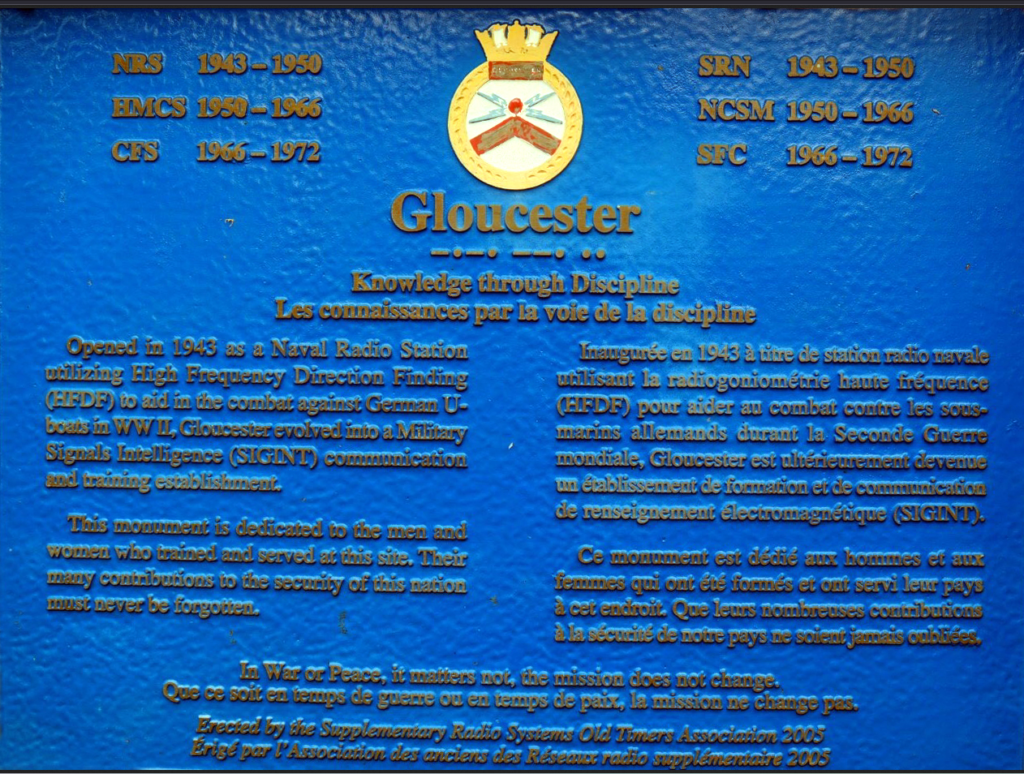Thanks to Fred VE3LAF for the suggestion of a brief reflection on HMCS Gloucester as the subject for OVMRC remembrance. Of note is that among those who served includes both Fred VE3LAF and Marcel VE3FNG.

HMCS Gloucester - “Knowledge through discipline” 1943-1972
Opened in 1943 as a Naval Radio Station utilizing High Frequency Direction finding (HFDF) to aid in the combat against German U-boats in WWII, Gloucester evolved into a Military Signals Intelligence (SIGINT) communication and training establishment.
This monument is dedicated to the men and women who trained and served at this site. Their many contributions to the security of this nation must never be forgotten.
In War or Peace, it matters not, the mission does not change.
Plaque above was erected by the Supplementary Radio Systems Old Timers Association 2005.

Cdr D.S.K. Blackmore was responsible for having this beautiful entrance to Gloucester built in 1959. The main gate is further from the back of the sign. Photo credit, D.S.K. Blackmore.

When Gloucester closed in 1972, this memorial plaque was dedicated to those who served there.
Brief Backgrounder on High Frequency (HF) Direction Finding (DF)
Radio communication influenced WW II much more than was realised by the early post war historians and by the general public. For example, though HF/DF (huff-duff) was known, the wide-spread understanding of its technology remains limited.
Watson-Watt was originally attempting to locate thunderstorms by detecting the radio emissions given off by lightning strikes. His contribution, made in 1916, was to use a cathode ray tube to indicate the bearing. Later on, the cathode ray tube was replaced by an oscilloscope.
High Frequency (HF) Direction Finding (DF), also known as "huff-duff", is a system that locates signals by using a set of antennas to receive signals from slightly different angles or locations:
- Receive signals: A set of antennas receive signals from different angles or locations.
- Compare signals: The system compares the signals to determine the bearing of the signal.
- Display bearing: The bearing is displayed on an oscilloscope as an ellipse or figure-8. The long axis of the shape indicates the direction of the signal.
The Royal Navy also implemented continuously motor-driven tuning to scan the likely frequencies and sound an alarm when any transmissions were detected.

Triangulation from multiple listening stations
Ships and shore stations were used to intercept signals from u-boats, often lasting no more than twenty seconds, triangulate their location and dispatch forces to attack them.
Huff Duff Aerial on a ship:

German u-boat tactics relied on the first u-boat that sighted a convoy shadowing it and transmitting regular sighting reports so that a wolf-pack could formed in its path. These transmissions were often detected by HF/DF and the hunter became the hunted. Together with radar and ASDIC (sonar), HF/DF was one of the tools that turned the Battle of the Atlantic in favour of the Allies and Huff-Duff played a part in some 20% of all u-boat sinkings as well as having a disrupting effect on u-boat tactics.

REFERENCES AND LINKS OF INTEREST
http://www.jproc.ca/rrp/rrp2/glo.html
https://uboat.net/allies/technical/hfdf.htm#google_vignette https://
www.junobeach.org/canada-in-wwii/articles/anti-submarine-detection/
https://www.quora.com/What-is-radio-direction-finding-and-how-did-it-work-in-World-War-II
https://www.worldnavalships.com/forums/thread.php?threadid=1011
Appears in: Rambler November 2024
